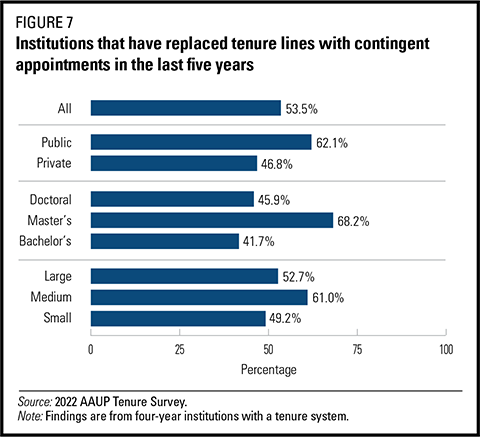The latest look at tenure
For those in the academic space, tenure is one of the top achievements for which to strive. It is commonly defined as an indefinite employment that can be terminated under only extreme circumstances. In other words, it’s really hard to get fired.
The American Association of University Professors released the findings of its most recent survey on tenure practices in May.
Changes to faculty workforce in the wake of the pandemic
The COVID-19 pandemic resulted in hiring freezes, eliminated positions, furloughs and salary reductions at colleges and universities.
In March, the College and University Professional Association for Human resources reported that, during the 2020–2021 academic year, all faculty types experienced job losses, and tenure-track positions specifically dropped by more than 2%.
In fact, CUPA-HR’s 2021 Faculty in Higher Education Report found that the two disciplines with the greatest faculty losses, in terms of sheer number of positions, were business and biomedical sciences.
“(O)ne-third to nearly one-half of institutions with faculty in these disciplines reported cuts in these faculty,” CUPA-HR wrote.
The report is intended to be an objective look at the state of tenure in higher education in the U.S, and, while it doesn’t focus on STEM fields specifically, the trends identified still apply to them.
Stopping the tenure clock
When someone is hired as a tenure-track faculty member, usually at the assistant professor level, they have a set amount of time to prove to those in charge that they deserve to be awarded tenure.
This probationary period, colloquially called the tenure clock, varies in length between schools and positions, but it typically is no longer than six years.
AAUP found that 96.8% of four-year institutions with a tenure system have this kind of probationary period, with the mean length being 5.7 years.
However, an inflexible, fixed tenure clock negatively affects those faculty members with family obligations (who are disproportionately women) and those who face extraordinary events (say, for example, a global pandemic) that can interrupt and extend research timelines.
Many institutions have implemented policies to stop the clock based on life events, such as the birth of a child or health reasons. Today, 82.3% of institutions surveyed by AAUP provide some sort of pause for these reasons, compared with just 17% in 2000. Of those that offer tenure clock pauses, 92.5% make that opportunity available regardless of gender.
AAUP also noted that there is a push to provide pauses on an individual basis for additional reasons as well, such as elder care.
While these policies are seemingly ubiquitous now, that has not always been the case, and that lack of accommodation has resulted in a long-term and gendered impact on primary caregivers, particularly women.
Other studies have noted that women are more likely to stop the clock for child-related reasons, thereby delaying promotions and salary increases. These effects are compounded over time, and the pandemic certainly has not helped, suggesting alternative arrangements are needed to correct for this aspect of the tenure system.

Diversity, equity, inclusion and tenure
Tenure practices directly affect an institution’s diversity, equity and inclusion, or DEI, climate. Tenure criteria may include implicit biases, such as not accounting for how service, mentorship and outreach obligations may disproportionately fall on underrepresented faculty members.
AAUP’s survey asked institutions if DEI criteria were included in tenure standards, if tenure criteria had been reviewed for implicit bias, and if tenure committee members had received training on implicit bias. DEI criteria were found in tenure standards at only 21.5% of the institutions they surveyed. Nearly 40% of institutions had reviewed their tenure criteria for implicit bias, and 40% had provided training on implicit bias to tenure committees in the past five years.
Many of the institutions that did not have practices to address DEI in place said they were considering them for the future.
Importantly, some respondents seeking to advance DEI in the tenure process noted that it’s not entirely up to employees of the institution. One noted that scholarly publications have their own biases. Another noted that state laws are upending workplace diversity training, writing, “We are in a state where proposed legislation would greatly restrict our ability to provide training regarding implicit bias.”
It’s hard to quantify how effective DEI efforts are when it comes to tenure, and the AAUP survey is the first to try to do so. If you’re in a tenure-track position or are going to be applying for one and are concerned about biases, it may be worth speaking to a tenure committee member or other mentor to understand what processes are in place to acknowledge and address biases.
Threats to tenure
In recent years, tenure-track and tenured positions have been harder to come by. Yet the stream of qualified applicants for them remains strong. At least, that’s what graduate students and postdoctoral researchers are often told. But is that actually true?
According to the AAUP, the answer is probably yes.
Institutions undermine tenure in numerous ways. One of them is by increasing the number of contingent appointments, or positions that are intentionally not on the tenure track (think about adjunct professors and similar positions). AAUP found that 53.5% of institutions have replaced tenure-track or tenured positions with fixed-term, contingent positions. This is a three-fold increase compared with five years ago.
External threats exist too. In February, Texas’ Republican lieutenant governor, Dan Patrick, said he’ll make ending tenure for new faculty at all public universities a priority for the next legislature, which convenes later this year. In April, Florida Gov. Rick DeSantis, also a Republican, signed into law a bill that would put even tenured faculty up for review every five years. Both cases are examples of the GOP’s broader effort to curtail instruction on racism and other forms of oppression.
But it’s not all doom and gloom if a tenured position is your goal. AAUP concluded its report on a positive note, saying that tenure “continues to serve as the bulwark in the defense of academic freedom.” The organization’s efforts to study the practices related to the tenure system will be used to better inform tenure approaches and hopefully preserve the system moving forward.
Enjoy reading ASBMB Today?
Become a member to receive the print edition four times a year and the digital edition monthly.
Learn moreFeatured jobs
from the ASBMB career center
Get the latest from ASBMB Today
Enter your email address, and we’ll send you a weekly email with recent articles, interviews and more.
Latest in Careers
Careers highlights or most popular articles

Building the blueprint to block HIV
Wesley Sundquist will present his work on the HIV capsid and revolutionary drug, Lenacapavir, at the ASBMB Annual Meeting, March 7–10, in Maryland.

Upcoming opportunities
Present your research alongside other outstanding scientists. The #ASBMB26 late-breaking abstract deadline is Jan. 15.

Designing life’s building blocks with AI
Tanja Kortemme, a professor at the University of California, San Francisco, will discuss her research using computational biology to engineer proteins at the 2026 ASBMB Annual Meeting.

Upcoming opportunities
#ASBMB26 late-breaking abstract submission opens on December 8. Register by Jan. 15 to get the early rate on our Annual Meeting.

Make your abstract stand out
Ensure your research is impossible to overlook. Get quick, practical reminders for crafting an abstract that attracts readers and helps you build connections at the conference.

Inside industry postdocs
As more Ph.D. scientists look beyond academia, industry postdocs offer a new kind of training, where mentorship meets mission-driven research. Fellows at Pfizer and Genentech share how these programs prepare them to translate discovery into impact.


